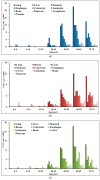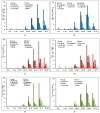Patterns of Life Lost to Cancers with High Risk of Death in China
- PMID: 31248218
- PMCID: PMC6617202
- DOI: 10.3390/ijerph16122175
Patterns of Life Lost to Cancers with High Risk of Death in China
Abstract
To inform public health policy and research, we analyzed the patterns of life lost to cancers and evaluated the cancer burden in China. Based on the published Chinese Cancer Registry Annual Report and related literature in 2013, we calculated the cancer-related mortality and potential years of life lost (PYLL) by age, sex, districts (urban or rural), to describe the patterns of life lost to cancers. The high death-risk cancers in China were lung, liver, stomach, esophageal, colorectal, breast, pancreatic, brain and nervous system, and ovarian cancers, and leukemia. Liver and esophageal cancers were more prominent among males, while breast and colorectal cancers were more prevalent among females. The most obvious differences of mortality between urban and rural areas were found in liver, esophageal, and colorectal cancers. Cancer-related mortality increased significantly after the age of 30 years, and peaking at 70-79 years. The PYLL rate of cancer in urban areas was higher than that in rural areas (21.49 vs. 19.20/1000), and significant regional and gender differences of PYLL ranks can be observed. For people aged over 60 years, cancer PYLL mainly came from lung, stomach, and esophageal cancers; for middle-aged people, it was mainly induced by liver, colorectal, and female reproductive systems' cancers; and for those under 30 years, life lost to cancer was mainly caused by leukemia and brain, nervous system cancers. Moreover, disparities in age distribution of PYLL from different regions and sexes can be found. In short, three categories of people, including those in urban areas, males and people over 60 years, were suffering from more serious cancer deaths and life lost. These variations pose considerable challenges for the Chinese health care system, and comprehensive measures are required for cancer prevention and treatment.
Keywords: cancers; death; high risk; life lost; patterns.
Conflict of interest statement
The authors declare no conflict of interest.
Figures






Similar articles
-
High Cancer Burden in Elderly Chinese, 2005-2011.Int J Environ Res Public Health. 2015 Sep 29;12(10):12196-211. doi: 10.3390/ijerph121012196. Int J Environ Res Public Health. 2015. PMID: 26426031 Free PMC article.
-
Potential years of life lost due to suicide in China, 2006-2010.Public Health. 2015 May;129(5):555-60. doi: 10.1016/j.puhe.2015.02.012. Epub 2015 Mar 11. Public Health. 2015. PMID: 25769349 Free PMC article.
-
Trends of potential years of life lost due to main causes of deaths in urban and rural population in Poland, 2002-2011.Ann Agric Environ Med. 2015;22(3):564-71. doi: 10.5604/12321966.1168657. Ann Agric Environ Med. 2015. PMID: 26403135
-
[SENTIERI - Epidemiological Study of Residents in National Priority Contaminated Sites. Sixth Report].Epidemiol Prev. 2023 Jan-Apr;47(1-2 Suppl 1):1-286. doi: 10.19191/EP23.1-2-S1.003. Epidemiol Prev. 2023. PMID: 36825373 Italian.
-
Challenges and Suggestions in Management of Lung and Liver Cancer in Uzbekistan: The Second Report of the Uzbekistan-Korea Oncology Consortium.Int J Environ Res Public Health. 2022 Sep 17;19(18):11727. doi: 10.3390/ijerph191811727. Int J Environ Res Public Health. 2022. PMID: 36142000 Free PMC article. Review.
Cited by
-
Burden of esophageal cancer in global, regional and national regions from 1990 to 2021 and its projection until 2050: results from the GBD study 2021.Front Oncol. 2025 Jan 20;14:1518567. doi: 10.3389/fonc.2024.1518567. eCollection 2024. Front Oncol. 2025. PMID: 39902130 Free PMC article.
-
Diagnostic potential of extracellular vesicle-associated microRNA-10b and tumor markers for lung adenocarcinoma.Oncol Lett. 2021 Aug;22(2):614. doi: 10.3892/ol.2021.12875. Epub 2021 Jun 23. Oncol Lett. 2021. PMID: 34257722 Free PMC article.
-
Age at initial diagnosis and prognosis of breast cancer: a nationwide multicenter retrospective study in China.Ann Transl Med. 2022 Aug;10(15):813. doi: 10.21037/atm-22-302. Ann Transl Med. 2022. PMID: 36034985 Free PMC article.
-
Changes in the disease burden of breast cancer along with attributable risk factors in China from 1990 to 2019 and its projections: An analysis of the global burden of disease study 2019.Cancer Med. 2023 Jan;12(2):1888-1902. doi: 10.1002/cam4.5006. Epub 2022 Jul 3. Cancer Med. 2023. PMID: 35785526 Free PMC article.
-
LINC00365 promotes miR-221-5p to inhibit pyroptosis via Dicer in colorectal cancer.Acta Biochim Biophys Sin (Shanghai). 2024 Oct 22;57(4):529-541. doi: 10.3724/abbs.2024173. Acta Biochim Biophys Sin (Shanghai). 2024. PMID: 39439418 Free PMC article.
References
Publication types
MeSH terms
LinkOut - more resources
Full Text Sources

